Nicolas Boulay is head of growth at Space Ape Games. This article was originally published on the Space Ape website.
How holistic experimentations on ad monetisation amplified with smart UA took Fastlane from 170,000 to 700,000 DAU in four months. And growing.
- Fastlane has reached 16m installs, approaching $30m run-rate, and is on an explosive growth trajectory 10 months after launch
- Fastlane is an evolved arcade shooter game available for free on iOS and Android phones
- From $5,000/d to $45,000/d from ads in four months: what are the lessons learnt from our holistic iterations and partnership with Unity Ads
- We are setting a new benchmark for ads at $0.13 ad arpdau in the US
- Our Ad LTV – lifetime value – is now based on true ad performance to gain accuracy
- We multiplied our user acquisition budgets by five-times with our lean team of two. And we are profitable under a month at $0.52 CPI direct
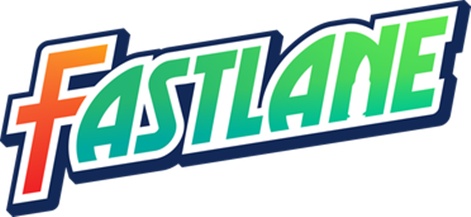
Fastlane was developed in six months by a team of eight people. The team’s thesis was that there was a gap in the market between hyper-casual and midcore titles.
A gap where casual addictive gameplay can meet $0.25+ arpdau in Tier-one geos, marrying IAP and ads while maintaining good retention metrics at 12 per cent d28 and attracting more than 100,000 new users daily.
We feel we’ve built a replicable growth engine with Fastlane. Better – we have improved our ad monetisation stack and our understanding of ad LTV – lifetime value – as well as forged long-term partnerships that will have a long lasting impact in our future strategies going forward.
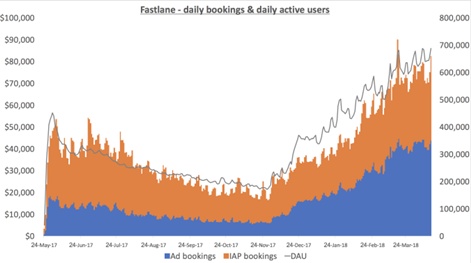
Fastlane’s stats by mid-March 2018, 10 months after launch:
- 16m installs, approaching $30m run-rate
- 700,000 DAU (up from 170k in nov 2017)
- 2.5M+ daily video views
- $80,000 daily booking (iap + ads), with highs approaching $100,000/d
- $45,000 daily booking with ads alone (up from $5k/d in nov 2017)
This article sums up our main learnings on our ad monetisation implementation and partnership that increased significantly our LTV. It also explains how global UA with key partners amplified its impact and led us, in four months, to profitably:
- Four-times DAU
- 4.5x revenue
- Five-times marketing spend while more profitable than before
Fastlane: Road to Revenge, an evolved mobile arcade shooter
Fastlane was launched in Mid 2017, a period of low risk growth and calculated bets for the studio – since then, we joined force with Supercell and are committed to make our mark on the gaming ecosystem, define a category hit and make a game that people will be talking about in 10 years time.
Despite, it not being our genre-defining game, Fastlane was, and is, a great learning ground for us in many aspects, including how to automate live ops in a casual game, how to integrate third-party content from YouTubers to a Kasabian soundtrack, ad monetisation and user acquisition.
I'm pleased to be able to share some of these lessons in this blog post.
Inspired by classic arcade shooters from the ’80s like Spy Hunter and 1942, Fastlane: Road to Revenge is a one-handed retro arcade shooter with RPG elements, designed to be played in short bursts. Players chase high scores in multiplayer leagues and leaderboards, collect, upgrade and customise exotic cars and unlock devastating vehicle transformations!
The game presents a huge motley crew of characters–many played by some of YouTube’s biggest gaming personalities - as well as powerful vehicle upgrades, outrageous events and fully customisable soundtrack with Apple Music integration.
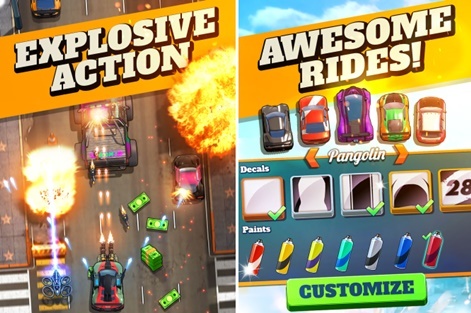
From $5,000/d to $45,000/day from ads in four months: the lessons learnt
An iterative approach
The success we’ve had in the last few months on Fastlane is a result six months of iteration and experimentation by the dev and marketing teams working closely co-located.
Fastlane was not our first attempt at in-game ads. We had included rewarded ad units in both Samurai Siege and Rival Kingdoms but in both cases the features were added post launch and not inserted into the core economy of the game and therefore were not additive.
In Fastlane we committed from the beginning to design the economy specifically for ad monetisation. This involved being very clear that we would create value for both players and advertisers.
This seems like common sense but previously our approach to in game ads was to just focus on the player experience. Of course no one is going to pay to advertise in your game if no players ever engage with the ads and ultimately install your advertisers’ (often a competitor) game.
Once you start from the position that you want your players to tap on these ads then you approach ad unit design very differently. Rather than focusing on how you can make the ad experience cause the minimal disruption to your gameplay, you focus on how you can ensure that once your players leave your game that they come back.
This was a very different mindset and the fundamental reason why Fastlane’s ad implementation has been so successful.
It also resulted in the team implementing ads with the LTV components and the player happiness as our top concern. Making sure we are chasing the big picture, not only increasing a parameter (views) and decreasing other ones (retention, IAP) in the process.
That was all fine in theory, but initially it was merely a hypothesis so we tested in Beta. Below is the outcome of a test we ran in beta where we forced interstitial ads after every race.
The result was pretty clear. It increased vastly the amount of interstitial views per day as well as ad revenue, but user retention dropped from day seven.
The overall result was negative as expected but it was a good exercise for us to go through as a studio and each subsequent hypothesis was tested in a similar way.
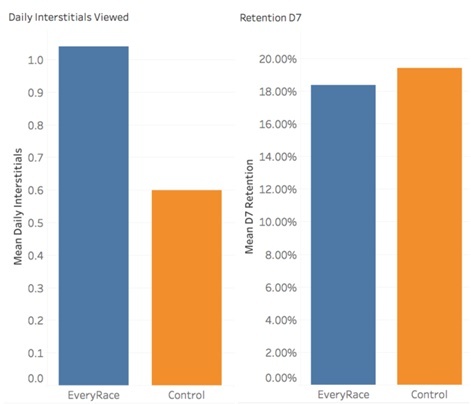
We were not ready to grow our short-term revenue while hurting our long-term retention. We made no compromise, canned that idea and tested some more.
We A/B tested different approaches to ads with a strict data driven approach and played with caps, frequencies, placements, formats and providers in order to end up with the design that you are seeing today.
Six months after the game’s global release we eventually found winning formula for that stage of the game’s life cycle. This was an optional rewarded ad at the end of almost every race, an interstitial showing up if you don’t make any IAP nor watch rewarded ad.
We also entered into an exclusivity partnership with Unity Ads in December 2017 using their unified auction to monetise our entire inventory that has proven to be pivotal in our growth journey.
This new setup increased ads arpdau to $0.13 net in the US and $0.18 in CN while we more than tripled our scale with more than 2.5m daily video views globally.
Here is our current ad performance per main geo, in term of weekly views and CPM:
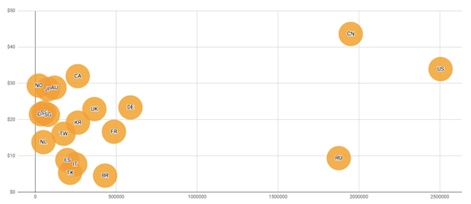
In addition to significantly increasing ad arpdau, we were able to confidently see in the data that impact on retention and the IAP cannibalisation was more than offset by the increase in ad revenue. LTV improved by 40 per cent overall.
Fastlane’s arpdau – average revenue per daily active user – in the US:
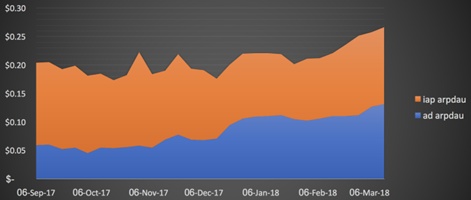
Our four ad design pillars
We had four pillars that guided our ad design methodology on Fastlane.
Pillar One – Ads must work for the player. Rewards needs to feel desirable and part of the core loop, yet complementary to IAP bundles.
Pillar Two – Ads must to be displayed at the right moment during the player’s session so that it does not impact negatively retention. In other words, show the ads when the player would be ending their session anyway.
Pillar Three – Ads must to be part of the game’s world. They need to feel natural for the player. They need to add to the world.
Pillar Four – The ad implementation must work for advertisers and drive installs. You should look at creating a placement where the players will want to interact with the ads in order to reach the highest CPMs possible, not necessarily the highest amount of views. Culturally this was the hardest pillar to implement as it is counter-intuitive to design to drive people to play competitor’s’ games!
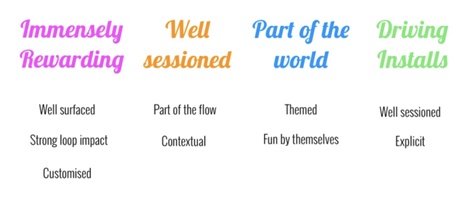
Fastlane’s key findings
Here are our main findings specific to Fastlane:
» Rewarded ads > Interstitial ads for player retention and CPM
85 per cent of our ad revenue is from rewarded ads and it does not hurt retention as the player has the choice.
» End of a race/session is the best placement for maximising CPM and player’s engagement with ads on Fastlane.
We want people interacting with the ads. In order to encourage that behaviour we found that a rewarded video at the end of a session generated 25 per cent higher CPM than giving the option to watch an ad at the start of a session.
» Giving significant rewards to a player for watching an ad does increase the engagement rate
And it does not cannibalise IAP bundles if the economy is ready for it. But your rewards must be set to levels that players would not otherwise buy with IAPs.
» Be upfront and unapologetic.
Watching ads is a clear value exchange and is part of the core aesthetic of the game. Not offering the option to pay to remove ads did work better for us. A Fastlane player should WANT ads. TV shows have been designed around ad breaks for years and our game is too as it’s the business model we’ve chosen from the start.
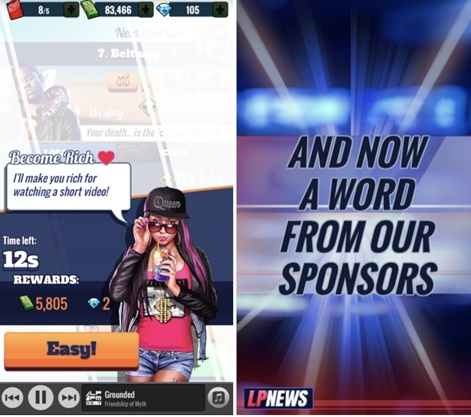
A different approach than our previous titles
This methodology differed vastly from the approach we took for Samurai Siege and Rival Kingdoms where the ad feature was added more than six months after the release of each game rather than designed with specific sinks and taps for ad rewarded currencies in mind.
This resulted in the rewards being either insignificant or cannibalising IAP in strategy games. Furthermore our strategy games had an aprdau of $1 to $2 from IAP, so the bar for in-game ads to be impactful in that economy was very high.
It should also be noted this lesson does not just apply to ads. The same is true for viral and social hooks that need to be designed as part of the core loop to have an impact.
An ad LTV model based on actual ad performance to gain accuracy for user acquisition media buying.
Understanding Ad LTV per campaign is arguably our big learning on ad monetisation. It is so easy to make bad decisions by becoming fixated on one or other metric, when ultimately the only metric that matters is LTV.
LTV calculation has been pivotal since the mobile app industry moved to free-to-play.
As a marketer in today’s industry, chasing profitable ROI and growth via targeted paid campaigns is key. LTV is based on complex predictive models when it comes to IAP and developers have become quite sophisticated in predicting what a user will spend over their lifetime just by analysing their behaviour in the first few play sessions.
Modelling LTV from IAPs at a user level is not trivial but it is well understood in 2018 and any game developer inherently has the data to do so because they need to associate a payment with a user account in order to deliver the relevant in-game item to the correct person.
However, when it comes to ad revenue, the ad LTV calculation is usually very basic. Historically we would crudely estimate how much revenue each individual user was generating from ads and this was fine because it was a very small part of our business.
However today advertising is a $12m-plus/year business for us – only a small percentage of our overall revenue but significant enough that we would invest in understanding it more and adapt our UA to it.
At launch, our crude ad LTV approach was to simply divide a country’s ad revenue by the number of ad views in that country, and then apportion the revenue per user depending on the number of ads they watched.
In the case of Fastlane in the US, ad LTV for the first two weeks with this method was between $0.40 and $0.64 per user depending on the source of the user.

However this is missing the point that most advertisers are bidding on performance, not on view, and that all views in a given country/platform are not necessary equal to another in term of revenue.
We since moved from that model and are now attributing revenue based on the true ads performance, data that we’re receiving as part of our partnership with Unity. Which gives us an ad LTV between $0.23 and $0.73 for Fastlane in the US per UA channel. A much bigger spread.

This was an eureka moment for the team and would allow us to tailor even more our UA bids to specific media that are bringing higher value users – like we’ve been doing for years with IAP.
We’re now tracking our ad monetisation performance not only with the sole amount of views/user/placement in mind, but also taking into account the actions triggered after watching an ad by our users in order to maximise ad arpdau.
Next step, we scaled up UA based on this data to deliver supersonic growth.
In addition to getting better performing ad placements in-game, and improving LTV, we were also getting better at optimising our UA campaigns.
During this time we managed to increased our oCVR% (installs/imps ratio) thanks to smart ASO and creative iteration from our in-house team and playable ads from partners that allowed us to reach much more scale at a reduced direct CPI of $0.52 from October onwards ($0.34 including organics).
oCVR% on our main video UA channel per month and per geo:
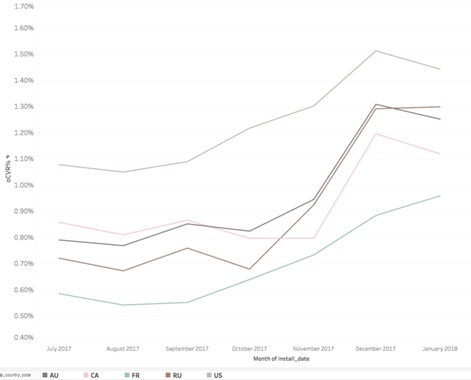
All these improvements in oCVR% and ad monetisation led to the growth we’re seeing today, multiplied by the rocket fuel that is smart UA spend.

We’re now spending north of $250k a week on marketing with our lean team of two, growing week on week, while profitable under a month at a $0.52 CPI. We know more on Ad LTV per campaign, we have higher LTV, lower CPIs, long term partners, better creatives iterations, and there is no coming back.
The lessons we will be taking forward to our future games will be:
- Design your game with ads in mind from the beginning if that’s the business model you choose. Use the pillars that we used for Fastlane (or adapt for the new game) and in particular design moments when you can effectively push your players to interact with an ad. Your CPM and ultimately revenue will reflect that.
- AB test and track all the impacts of any changes to the in game ads implementation and focus your KPI on LTV improvements, not views.
- Attribute ad LTV precisely at a user level so you can target UA campaigns to the kind of people who will generate more revenue from interacting with ads
Get the latest news, interviews and in-depth analysis on Twitter, Facebook and our daily newsletter.





















